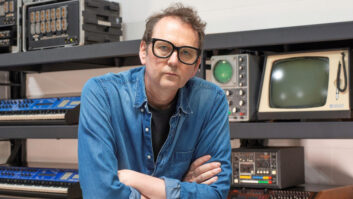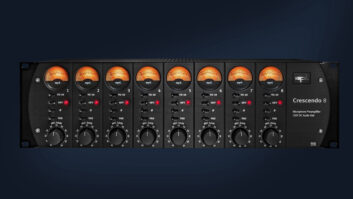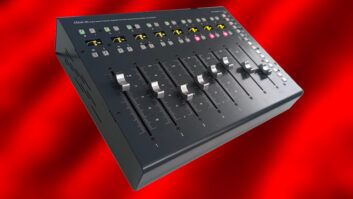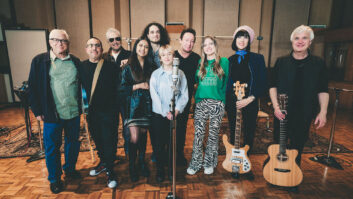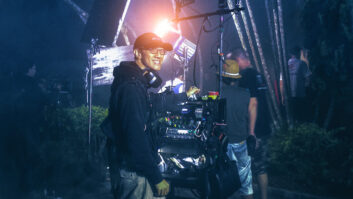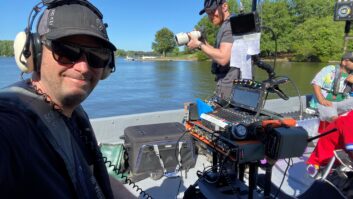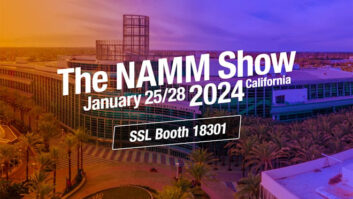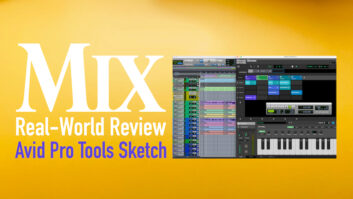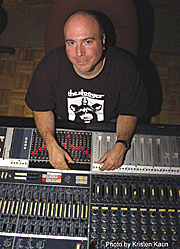
We’ve heard the gripes, even participated in many of them: the roster cuts, the shrinking budgets; the home studio’s rise, the commercial studio’s decline; the lack of work, the vacant rooms, the silent phones; the flaky client, the fickle consumer. We’ve also heard ad nauseum the negative assumptions bellowed by both the cynically informed and the ignorantly outspoken, such as commercial studios are dead. Or dying. Or worse, those big live rooms are just a waste of space anyway, and all of that analog gear is just too big and too slow. Who needs it when you’ve got a fully loaded mega-meg hard drive and 50,000 plug-ins at your disposal? One can make an absolutely technically perfect record at home, in their pajamas, on their computer with absolutely no contact with any other instrument or any other human being whatsoever, right? Not quite. Not even close.
How long you work on a record now depends on two things: how well a band plays and how much money they have.
—Joe Barresi
Contrary to what the naysayers suggest, the commercial studio industry is not dead. Not even dying, for that matter. However, it is adjusting itself to a new business model, one thrust upon it as a result of a radically altered music landscape and slimmed-down recording budgets. In commercial studios across the U.S., most of the overdub business left for producer/engineer-owned spots years ago, mostly out of monetary necessity. Shivaun O’Brien, manager of Sound City Studios in Los Angeles, notes that one regular client built his own studio across the parking lot, where he works after tracking in Sound City’s Studio A. “They just can’t afford to stay at Sound City for overdubs,” says O’Brien. “Engineers and producers get called to do [an album] for $50,000 and it’s an all-in deal. They’re trying to figure out how to keep at least some of the money.”
Producer/engineer Joe Barresi, who recently co-produced, engineered and mixed Queens of the Stone Age’s latest, Lullabies to Paralyze, adds that he and many of his peers spend less time overdubbing, as well. “Nowadays, you won’t spend two months doing overdubs; you’ll spend two weeks. That’s good in a way because it keeps things fresh. And if you have to mix two or three songs a day, you do it, instead of mixing one song every two days.”
Jason Carmer, a San Francisco-based producer/engineer with credits such as Third Eye Blind, Live and The Donnas, agrees. “In the past, we’d do the whole thing at Skywalker Sound, The Plant or the Hit Factory in New York. Maybe you could do that these days if you’re working with a band that’s really established and you have a larger budget, but most of the time, you can’t…unless you want to go instantly broke.”
For his most recent projects, which include producing/engineering new albums for The Explosion and the Star Spangled, Carmer usually spends a minimum of two weeks on pre-production, whips out basic tracks in a commercial facility and then moves to his studio to overdub and mix. Of course, Carmer has the advantage of owning a Helios console — much more of a board than what’s found in most home/project studios.
To make the most of scheduled tracking dates, Carmer makes sure his acts are well prepared before they enter the studio. “Now that budgets are tighter, the more you have your stuff together, the easier it is to go in and plug it out,” he says. “I did a lot of the Star Spangled record at Coast [in San Francisco], which has this ’60s sound. I got all the drums there, and a lot of the vocals, guitars and bass. Then I’d go to my place and hole up and do overdubs.”
Barresi also focuses more on pre-production, aided now by the Internet and digital technology. “I can get music from bands anywhere in the world,” he says. “They e-mail me songs and I’ll burn a CD, load it into Pro Tools and experiment with listening and re-arranging songs in that medium. Or if the band’s local, I can just bring a laptop and Mbox [to pre-production], record the band live, go home, do a little editing, burn a CD, bring it back to the band and say, ‘What do you think?’ We can get the arrangements together before we even start rehearsing.”
Barresi is one of the remaining few who doesn’t have a dedicated project studio (yet; he’s in the process of purchasing a Pro Tools|HD rig) and will record an entire project in commercial facilities; however, he doesn’t waste a lot of time. “I never really worked at the $2,000-a-day studios anyway,” he says. “I love places like Sound City. It’s a mid-studio price-wise, and if I can’t afford to stay there for two or three weeks, then I cut the drums there and move to a studio that’s cheaper to do all of my overdubs. I’d spend a little more time in that environment and spend more money mixing in a proper studio — it’s important for me to be in an environment where you can hear everything clearly.”
Miami-based engineer/mixer/producer Charles Dye, who mixed Ricky Martin’s Number One smash “Livin’ la Vida Loca” entirely “inside the box,” works primarily in the Pro Tools environment, whether it’s mixing on the maxed-out HD system in his own studio, The Gate, or tracking at Martin’s elaborate home studio. He often works in these non-commercial spaces at the artist’s request or for budgetary reasons. Nevertheless, he would prefer to work elsewhere. “The pop projects I do are usually major label and with larger budgets, but nonetheless, they’re smaller than pre-9/11,” he says. “I would love to work in a million-dollar room [more often], but — especially with the rock projects I produce — we just can’t afford it.”
Dan Huff, Nashville-based producer of major-label acts such as Faith Hill, LeAnn Rimes, Megadeth and Keith Urban, uses his Pro Tools/Control|24 — equipped home studio mainly for editing and minimal overdubs, choosing to do most of his work at studios such as Emerald Entertainment. Cutting corners hasn’t been much of an issue for Huff, but he does enjoy being able to work after taking his kids to school, for example. “As far as listening and going through the massive amounts of information we have to deal with, it’s a real godsend,” he says. On the other hand, some clients prefer to work at the Huff household, especially country music artists who are known to tour 250 to 300 days a year. “They’re off the road and it’s more relaxing for them to come over and sing in your house,” explains Huff.
AT YOUR SERVICE
Whether he works at home or at Emerald, Huff and other clients can take advantage of Emerald’s expanded technical services, which is one example of how a commercial studio can maintain a competitive edge in our trimmed-down industry.
“We go to producers’ houses with FireWire drives and fix Pro Tools systems. We send files all over the world for clients,” says Andrew Kautz, COO of Emerald Entertainment Group, which operates five separate facilities in Nashville on Music Row: the original Emerald Studios, Masterfonics Mastering, the Tracking Room, the Love Shack and Sixteenth Avenue Sound. “Before, we could basically just wait for the phone to ring, whereas now clients have a lot more choices and we have to adapt to that.”
“It’s a ‘whatever it takes to get the record done’ kind of mentality,” notes O’Brien. “Everyone steps up to the plate. A lot of times, even my crew will loan equipment to sessions, and producers will loan each other pieces of gear instead of them having to rent. Our assistants might help out a client at home or the runner might lend them pedals, amp heads, et cetera. It’s what you have to do, and in a way, it’s not a bad way to work. It makes everyone re-focus on what they’re doing.”
This sort of flexibility is key in booking, as well — up to a point. There’s a fine line between being flexible with scheduling and day rates and getting taken advantage of. Emerald has 10 rooms, ranging from $400 to $2,500 per day, so they can match a client with a room that suits their budget pretty easily. “I just hold our department heads accountable for a monthly budget and it’s proven very effective,” says Kautz. “We’d love to have [card rate] but the main thing is making sure your customer can get done what they need to get done. Also, we find that if a producer cancels two days one week and we work effectively with him, more than likely, it comes back as a week or a month [booking] down the road — karma in booking, I guess!”
Barresi counters, “Some of the larger studios are too concerned about ‘You were supposed to start at noon and you showed up at 1, so you’re already over an hour, and there’s overtime, and there’s a six pack of Coke in the fridge and if you drink more than six it’s $3 extra a can.’ People are going to work in their houses, but you want to make them come to your place to at least do their mixing or drum tracking. Maybe you’ve got to open up a smaller room or cut a room in half and have a lesser dollar value place where they can work every day and not stay in their home. There are benefits to that, as well.”

I do not think the
studio business is bleak.
I do think it’s time for
studios to stop taking
the bullshit.
—John King
Some producers, realizing their need to separate work and home, are returning as regular residents. It’s a win-win situation: Studios keep their rooms filled and producers can take advantage of the creative community and accoutrements of the commercial environment. John King, president of Chung King Studios in New York City, rents six of his nine rooms to resident engineer/producers. Outside clients such as Joss Stone, Usher and Kanye West also win, as the studio’s three commercially available rooms contain the absolute best gear from the Chung King inventory. Later this year, the studio will also become the recording home for the newly launched Chung King Records, which promises to bring even more revenue to the 20-year-old company. He adds, “anybody who wants to make a fortune is in the wrong business; what you do with your studio — that’s the future.”
The presence of longtime regulars such as producer/engineer Jim Scott, Rick Rubin, Jack Joseph Puig and Barresi has enabled Sound City to maintain steady bookings (and rates) since the post-9/11 slump, O’Brien says, but with shorter-term projects. They charge on a “three-tier” system “that works great for the indies,” she says. “They cut us a check up front and we give them a lower rate. But in the last year, the majors all of a sudden want the cash rate. Usually it takes them three months to pay you, but if they can get a lower rate, they’ll get you a check the next day!”
Sure, our industry’s shifting budgets and business models have brought on a lot of anxiety. But by taking a positive and proactive stance, we could emerge a stronger, albeit leaner, recording machine able to weather our stormy market. Come to think of it, we already are.
